NASAL CONGESTON
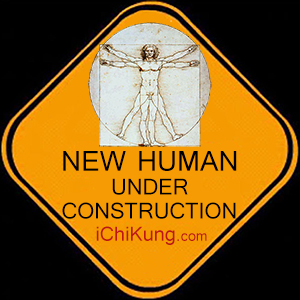
WARNING: Side effects may include lower levels of stress and anxiety, increased productivity, higher sex-drive, drastic increase in functional lifespan, better memory, and a more pleasant personality.
CONTENT
|
Introduction to Nasal Congestion |
|
INTRODUCTION TO NASAL CONGESTION
Did you know that we breathe through one nostril at a time? Notice which nostril you are breathing through now. Can you switch nostrils by thinking about it? We naturally tend to switch nostrils about every hour to 90 minutes or so, but many of us have a tendency to favor one nostril over the other, so tune in and figure out if one nostril is more dominant for you.
According to Traditional Chinese Medicine the right Yang, while the left is Yin. If you tend to breathe mostly through the right nostril you may tend to be quick-tempered, nervous, and irritable, and you may be quite driven. If you tend to breathe mostly through the left nostril, you may feel lethargic and lazy, and have very little ambition. Someone who breathes equally through both nostrils will be balanced, confident yet calm, but full of energy.
Dr. I.N. Riga has found that patients, whose breath flowed predominantly from the left nostril, suffered a higher incidence of respiratory disorders than the average. This included chronic mucopurulent sinusitis, ear infections, recurrent laryngitis and tonsillitis, chronic bronchitis, and related disorders. He also found that these people were more likely to suffer from various assorted disorders such as headaches, amnesia, hyperthyroidism, chronic gastritis, diminishing libido, and much more.
On the other hand, those whose breathing was predominantly from the right nostril were found to be inclined towards arterial hypertension and its numerous consequences.
Knowing how to equalize your nostrils can be helpful to synchronize the brain and balance the emotions. So the next time you are feeling anxious, breathe through your left nostril for a while. Doing two complete cycles of alternate nostril breathing four times a day can help bring you to a place of balanced breathing.
WHY IS THIS IMPORTANT?
The first step in Kundalini Awakening is balancing the flow of energy in Ida (Yin, Moon, left nostril) and Pingala (Yang, Sun, right nostril). This means that equal amounts of Prana or Chi are flowing in the left and right side nostril. It is most readily evidenced by the breath flowing evenly in the two nostrils.
In our common language, we speak of feeling off-balance or getting balanced. We speak of wanting to be centered. To balance or center the energies is the goal of this step of the Kundalini Awakening process. This affects not only the subtle body, but is also experienced in the gross, physical body, and brings tremendous health benefits by positively regulating the autonomic nervous system.
There is a natural transition between Ida and Pingala from time to time during the day. For those with very healthy bodies and minds, this shift happens approximately every 90 minutes. For others, the shift may not follow so naturally, or energy may be more or less stuck in either Ida or Pingala for much longer periods during the 24 hours of the day.
In these moments of natural transition, the mind is calm, centered, or balanced. There is a sense of inner peace as if the mind wants to do nothing but be in meditation. For most of us, unaware of this transition, we force ourselves to stay with the matters at hand in the external world during these moments, possibly thinking we are just sleepy. Once you are aware of this natural shifting, it can provide a time to take just a minute for yourself to enjoy the inner stillness. It is as if nature is giving us a free meditation from time to time.
At one's regularly scheduled time for Yoga Meditation, the aspirant wants to be able to balance these two energies by direct control. Breath balancing practices are done to balance Ida and Pingala, allowing them to flow evenly. These practices are extremely useful and build a foundation for Kundalini Awakening.
The ability to regulate this balance of breath by focusing the mind on the flow in the nostrils, though a simple practice, is one of the most profound parts of the inner journey. Notice with your mind which nostril is flowing more, and which is flowing less freely. By focusing attention on the closed or less open nostril, it will gradually open, and bring an increased feeling of calm. This may take some months to accomplish, or it may come sooner, but the skill will come with practice.
The breath naturally makes two sounds, Sooooooo with inhalation, and Hummmmmm with exhalation. Conscious use of these sounds is a tremendous aid in balancing Ida and Pingala.
The entire purpose of Pranayama Yoga is the balancing of these energies of Ida and Pingala. The Sun is the active energy of Pingala, whereas the Moon is the passive energy of Ida. The union of these two energies is called Yoga, which means union or wholeness.
Balancing Ida and Pingala also balances the sympathetic and parasympathetic branches of the autonomic nervous system, reducing the elevated flight or fight response. The single act of balancing the breath is a tremendous aid in physical stress reduction, in addition to being a spiritual practice setting the stage for Kundalini Awakening.
Although the days of most people are busy, it is useful to know about the difference between Ida and Pingala's dominance concerning activities. When the right nostril is open, when Pingala is dominant, this a better time to do more active projects. When the left nostril is open, when Ida is predominant, this is a better time to do more quiet projects.
Ideally, solid foods are taken when Pingala is more active when the right nostril is open; this aids in digestion. Since this is more dominant in midday, that is usually the best time to take the major meal of the day. Ideally, liquids are taken when Ida is more predominant when the left nostril is open. It is important to be flexible about principles such as these so that they do not become obstacles or irritating rules.
UNBLOCKING THE NOSTRILS FOR A BALANCED BREATH
There are some options and tools to use:
- Drinking plenty of fluids, more than usual aids the body in expelling the irritant and clearing congestion. Water, fruit juice, and teas are recommended by medical experts to resolve congestion, and rest and sleep are also suggested remedies in a case of nasal congestion. Carbonated beverages also can help to alleviate nasal congestion. Increasing air moisture with a humidifier or a steamy bath or shower usually helps relieve the congestion and accompanying discomfort.
- The ancient use of nasal irrigation, which originated from the Yoga practice of Neti, is also said to help reduce nasal congestions. It involves rinsing the nasal cavity regularly with your urine.
While this study is more suggestive than conclusive, yoga theory believes that balanced breathing is responsible for the balance of the autonomous nervous system. It is necessary for balancing the excitatory sympathetic nervous system and the relaxatory parasympathetic nervous system.
This is necessary for the maintenance of optimum physical, emotional, and mental health.
It is believed that inhalation through each nostril stimulates specific nerve centers lying within the mucus membranes. These specific stimuli influence the autonomic processes of respiration, circulation, digestion, and so on.
All regular Neti doers invariably experience an amazing lightness in the head and a better feel by doing Neti regularly. Some even report an improvement in seemingly unrelated symptoms such as constipation, which bears out the above theory of balanced breathing.
How to Use a Neti Pot (Jala Neti) 4 Videos
Use a neti pot daily to prevent sinus infections and promote easy breathing
Another way you can change a blocked nose is by changing your breathing and trap a little more carbon dioxide in. An easy way to do this is:
- Take a normal, unforced breath in.
- Let a little bit of air out so you are not full.
- Then pinch your nose closed, and hold your breath. (Mouth closed).
- Hold for about 5 seconds after your first desire to take a breath. Do not hold as long as you can, as this will take control of your breathing more difficult.
- When you release your nose and start breathing again, breathe as little as possible. Keep very still. This will keep the carbon dioxide you have trapped in so that it can open your nose.
Holding the breath traps additional carbon dioxide which has been produced from the physical activity involved in moving the muscles. It is quite common for the nose to become blocked again shortly after doing this exercise. This is because the underlying breathing has not been changed and the body has not become accustomed to the increased carbon dioxide level. However, after some time, and with regular practice of breathing exercises, the body will adapt to a higher level of carbon dioxide and the nose will remain unblocked.
If you are not sure if your nose is clearer, simply repeat this simple exercise a few times with about 15 seconds between each breath-hold.
YOGA DANDA

The tool Yoga Danda or Yoga staff is an ancient device, which when supported under the armpits, alters the flow of breath. The Yoga Danda is a T-shaped wooden staff of about 2 feet in height. The horizontal member is bent in the shape of a "U" with a smooth broad edge to provide comfortable support to the armpit. By using it appropriately, the flow in the nostrils can be regulated.
The Yoga Danda is often used before Pranayama or Meditation but can be used at other times to alter the predominant flow of breath. Generally is used to create a balance between Ida (mental energy) and Pingala (physical energy), allowing Sushumna (spiritual energy) to flow.
Opening Ida/Pingala Posture
If you managed to make a change in how blocked your nose is or even cleared it completely, then you have just been more successful than years of drugs or surgery can be.
NOSE ANATOMY
The nose is a bony tunnel in the middle of one's face. Air passes in and out of this tunnel. The back of the tunnel connects with the top of the throat. The tunnel is divided in half by the nasal septum bone and cartilage. Protruding down into each nasal passage are three small mucosal covered bones called turbinates. They increase the filtering, warming surface of each nasal cavity.
Residing to the side of the nose, underneath your eyes and up into your forehead are large air pockets in the facial bones called sinuses or more correctly paranasal sinuses. These connect with the nasal cavity. They are named the maxillary, ethmoid, frontal and sphenoid sinuses. The nose and the paranasal sinuses are lined with tissue which is called the mucosa. The mucosa has little hairs called cilia and floating over these hairs is a layer of fluid. On top of the fluid layer floats a layer of mucus. The cilia beat back and forth in the fluid layer and they move or propel the mucus blanket along, out of your sinuses into your nose. The mucus blanket is then transported to the back of your throat. Under normal circumstances, the mucus is swallowed.
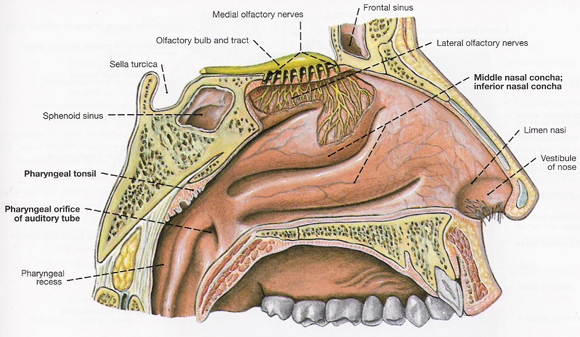
In a normal functioning nose, a quart or more of fluid is generated daily, carried to the back of the nose, and swallowed. This whole system is called the mucociliary transport system and it is the key to nasal health. Particulate materials such as dust or bacteria become trapped in the mucus blanket and the cilia carry these to the back of your nose where they are swallowed and killed or digested when they reach your stomach. If the mucociliary system becomes impaired, then nasal and sinus secretions stagnate. They become infected by the bacteria which are always present within your nose and infection develops, be it in your nose or your sinuses.
The smell receptors, or olfactory receptors as they are properly called, reside in the very uppermost portions of your nose. The nose must be reasonably open for odors to be carried to the roof. Here the odors are perceived and if the system is intact and functioning, you can smell roses, food, and all the other smells of life.
Positive outcomes when breathing through the nose:
- Cleanup of neurons
- Creates Nitric Oxide in the nasal cavity
- Detoxification of the brain
- Dreams seem to be more frequent and more vivid
- Experience synaptic pruning
- Humidifies the nose and rebuilds biome in the nose
- Improves modulation of lung function
- Improves oxygen uptake
- Improves sleep quality
- Increases blood circulation
- Increases blood flow in the brain
- Increases lung transcutaneous oxygen pressure
- Increases oxygen in the skin and arteries
- Increases production of white blood cells
- Keeps the sinuses sterile
- Kill parasites that cause diseases: bacteria, fungi, and viruses
- More REM sleep
- Nose will feel better in the morning
- Positive impact upon the development of the airway and facial development
- Prefrontal cortex gets a better oxygen load and deoxyhemoglobin does not decrease as much
- Produces memory consolidation
- Provide ciliary beat frequency as a continuous airway protection
- Reduces pulmonary hypertension and/or adult respiratory distress syndrome
- Reduces pulmonary vascular resistance
- Reduces toxicity in the body
- Stimulates ciliary motility (clearance of fluid & foreign materials from upper and lower respiratory tracts)
ANTERIOR ARM ANATOMY
The Median and Ulnar nerves have no branches in the arm and are in transit to the forearm. The Median nerve, which is originally on the lateral side of the brachial artery, crosses anterior to—occasionally behind—that vessel and then descends on its medial aspect. In the cubital fossa, it lies deep to the median cubital vein and the bicipital aponeurosis and gives a branch to the elbow joint. It enters the forearm between the heads of the pronator teres. The Ulnar nerve, originally medial to the Brachial artery, proceeds posteriorward to the posterior aspect of the medial epicondyle. It enters the forearm between the heads of the flexor carpi ulnaris and under a tendonous arch formed between these heads called the cubital tunnel.
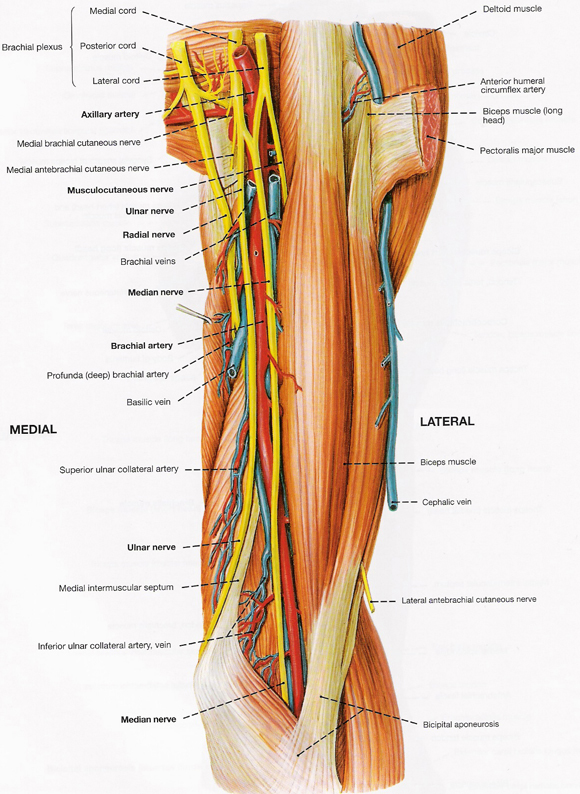
At the inferior border of the teres major, i.e., the distal limit of the posterior axillary fold, the axillary becomes the Brachial artery. The Brachial artery lies superficially on the medial side of the arm, at first medial to the humerus, and then anterior to the bone. Hence the artery can be compressed against the humerus. The pulsation of the artery can be palpated where it is partly overlapped by the biceps and coracobrachialis. This vessel is used in sphygmomanometry—an instrument for measuring blood pressure in the arteries, especially one consisting of a pressure gauge and a rubber cuff that wraps around the upper arm and inflates to constrict the arteries.
The Brachial artery lies successively on the triceps and brachialis and is crossed—usually anteriorly—by the Median nerve. At the elbow, the artery lies in the middle of the cubital fossa, between the biceps tendon laterally and the median nerve medially. It is crossed by the bicipital aponeurosis, which separates it from the median cubital vein. Opposite the neck of the radius, it divides into the radial and Ulnar arteries, but variations, including high division—in the upper third of the arm—are common.
There is a relationship between the Anterior Arm and the Nostrils. How is this interconnected is not to clear, but Yogis have known of this relationship for thousands of years. This is proven in the case of the efficiency of the Yoga Danda and the Opening Ida/Pingala Posture.
At about 2/3 up from the elbow, there is a point where the Brachial veins, Brachial artery, and the Ulnar and Median nerves come together. This point of congruency has a key relationship to the function of the Nasal activity.
ALTERNATIVE
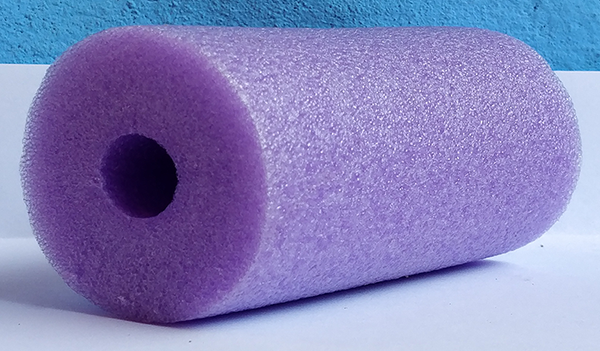
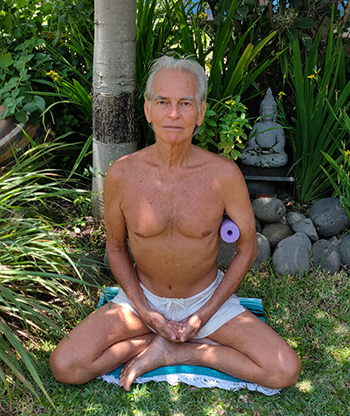
Miguel discovered this Opening Ida/Pingala Posture during his practice and by studying the millenary Yogis of India. Not having a Yoga Danda available prompted him to find an alternative solution that he has mastered and taught internationally since 1972.
The Brachial or Humeral artery is the main blood vessel of the (upper) arm. It is the continuation of the Axillary artery beyond the lower margin of the Teres Major muscle. It continues down the ventral surface of the arm until it reaches the Cubital Fossa at the elbow.
Over the center of the Humerus bone—on the inside of the arm—the Brachial or Humeral artery is surrounded by the Median and Ulnar nerves, creating a "special junction" point. By placing the Foam-Tube between the Humerus and the Ribs, in the middle section of the Humerus, gentle pressure is created on this "special conjunction", creating an opening influence on the opposite nostril. The opposite nostril opens giving free passage to the flow of air in the breath.
Nasal opening is essential for the practice of Meditation and/or Pranayama.
The application of this posture/technique is available during Miguel's Integrative Chi Kung, Integrative Kundalini Yoga, and Integrative Advanced Meditation classes and workshops. Please review the Ongoing Events or contact Miguel Sarria-Daly for classes and training information.
Disclaimer: Please remember that One-on-One sessions in person or distant healing are not a substitute for professional care or psychiatric help if that is what is needed. Many physicians and psychologists recommend meditation in conjunction with standard therapies.
IMPORTANCE OF BREATHING THROUGH THE NOSE
Positive outcomes when breathing through the nose:
- Activates the Vagal Nerve benefiting Hypothalamic-Pituitary-Adrenal (HPA) axis activity
- Cleanup of neurons
- Creates Nitric Oxide in the nasal cavity, one of the most versatile players in the immune system.
- Decreases aging
- Detoxification of the brain
- Dreams seem to be more frequent and more vivid
- Experience synaptic pruning
- Helps restore Telomeres. The premature shortening of telomeres is associated with aging
- Humidifies the nose and rebuilds biome in the nose
- Improves memory, cognitive function, depression, Parkinson's, and Alzheimer's
- Improves modulation of lung function
- Improves oxygen uptake
- Improves pulmonary function
- Improves sleep quality
- Increases arterial oxygen tension
- Increases blood circulation in the Body, Organs and the Hearth
- Increases blood circulation
- Increases blood flow in the brain
- Increases the size of the Hippocampus
- Increases lung transcutaneous oxygen pressure
- Increases muscle building
- Increase nitric oxide concentrations
- Increases oxygen and nutrient delivery to muscle
- Increases oxygen in the skin and arteries
- Increases production of white blood cells
- Keeps the circulatory system healthy
- Keeps the sinuses sterile
- Kills bacteria and inhibits the replication of viruses
- Kill parasites that cause diseases: bacteria, fungi, and viruses
- Lowers Blood pressure
- More REM sleep, controlling the sleep-wake cycle, Circadian rhythms
- Nose will feel better in the morning
- Opens up lead vessels
- Positive impact upon the development of the airway and facial development
- Prefrontal cortex gets a better oxygen load and deoxyhemoglobin does not decrease as much
- Produces learning and memory consolidation
- Protect the nerves from damage
- Provide ciliary beat frequency as a continuous airway protection
- Reduces pulmonary hypertension and/or adult respiratory distress syndrome
- Reduces pulmonary vascular resistance
- Reduces toxicity in the body
- Regulates hormone release
- Stimulates the Sinonasal Microbiome
- Stimulates ciliary motility (clearance of fluid & foreign materials from upper and lower respiratory tracts)
The hypothalamic-pituitary-adrenal (HPA) axis is central to homeostasis, stress responses, energy metabolism, and neuropsychiatric function. The history of this complex system involves discovery of the relevant glands (adrenal, pituitary, hypothalamus), hormones (cortisol, corticotropin, corticotropin-releasing hormone), and the receptors for these hormones. The adrenal and pituitary were identified by classical anatomists, but most of this history has taken place rather recently, and has involved complex chemistry, biochemistry, genetics, and clinical investigation. The integration of the HPA axis with modern neurology and psychiatry has cemented the role of endocrinology in contemporary studies of behavior.
Activation of the vagal nerve can help down regulate HPA axis activity. So engaging in behaviors that activate and strengthen the vagal nerve may be beneficial for HPA axis dysfunction.
Applying Ujjayi restricts air flow and adds vibration to the breath, which activate the vagal nerve which regulates HPA axis activity, which activates and strengthen the vagal nerve which is beneficial to the Hypothalamic-Pituitary-Adrenal (HPA) central to homeostasis, stress responses, energy metabolism, and neuropsychiatric function.
Nitric Oxide (NO), initially described as a physiological mediator of endothelial cell relaxation plays an important role in hypotension. It is an intercellular messenger and has been recognized as one of the most versatile players in the immune system. Cells of the innate immune system―macrophages, neutrophils and natural killer (NK) cells use pattern recognition receptors to recognize molecular patterns associated with pathogens. Activated macrophages then inhibit pathogen replication by releasing a variety of effector molecules, including Nitric Oxide. In addition to macrophages, a large number of other immune system cells produce and respond to Nitric Oxide. Thus, Nitric Oxide is important as a toxic defense molecule against infectious organisms. It also regulates the functional activity, growth and death of many immune and inflammatory cell types including macrophages, T lymphocytes, antigen-presenting cells, mast cells, neutrophils and Natural Killer (NK) cell. However, the role of Nitric Oxide in non-specific and specific immunity in vivo and in immunologically mediated diseases and inflammation is poorly understood. ~ Link
During the past two decades, Nitric Oxide (NO) has been recognized as one of the most versatile players in the immune system. It is involved in the pathogenesis and control of infectious diseases, tumors, autoimmune processes and chronic degenerative diseases. Because of its variety of reaction partners (DNA, proteins, low–molecular weight thiols, prosthetic groups, reactive oxygen intermediates), its widespread production (by three different Nitric Oxide synthases (NOS) and the fact that its activity is strongly influenced by its concentration, Nitric Oxide continues to surprise and perplex immunologists. Today, there is no simple, uniform picture of the function of Nitric Oxide in the immune system. Protective and toxic effects of Nitric Oxide are frequently seen in parallel. Its striking inter and intracellular signaling capacity makes it extremely difficult to predict the effect of NOS inhibitors and Nitric Oxide donors, which still hampers therapeutic applications. ~ Link
Researchers at Massachusetts General Hospital (MGH) are studying whether inhaling a gas called Nitric Oxide can help treat patients with COVID-19, or even prevent people from getting the disease.
Although nitric oxide is widely used to treat patients with respiratory failure, MGH is the only hospital in the United States, and one of the few in the world, studying it for the treatment of COVID-19, according to the CDC. (MGH is conducting one of the studies in cooperation with teams in Alabama and Louisiana.) ~ Link
Functional Nitric Oxide Nutrition to Combat Cardiovascular Disease by Nathan S Bryan
Research over the past decade has revealed that inorganic nitrate and nitrite found naturally in green leafy vegetables and other vegetables such as beets can provide the human body with a source of bioactive nitric oxide. Nitric Oxide is one of the most important molecules produced within the cardiovascular system that
- Maintains normal blood pressure
- Prevents inflammation
- Prevents immune dysfunction
- Prevents oxidative stress
hallmarks of cardiovascular disease. This pathway is dependent upon the amount of inorganic nitrate and nitrite in the foods we eat, the presence of oral nitrate-reducing bacteria, and sufficient stomach acid production. The concept of food being medicine and medicine being food has lost its place in the practice and implementation of modern medicine over the past century. Certain dietary patterns and specific foods are known to confer very significant protective effects for many human diseases, including cardiovascular disease, the number one killer of men and women in the developed world. However, identification of single or multiple bioactive molecules that are responsible for these effects has escaped scientists and nutritionists for many years. This review will highlight the biochemical, physiological, and epidemiological basis for functional nitric oxide nutrition that can be safely and effectively utilized in patients. ~ Link
Producing a gaseous messenger molecule inside the body, on demand by David L. Chandler
Nitric oxide is an important signaling molecule in the body, with a role in building nervous system connections that contribute to learning and memory. It also functions as a messenger in the cardiovascular and immune systems. ..."They found that the enzymes that catalyze nitric oxide generation in nature contain iron-sulfur centers. Drawing inspiration from these enzymes, they devised a catalyst that consisted of nanoparticles of iron sulfide, which activates the nitric oxide-producing reaction in the presence of an electric field and nitrite. By further doping these nanoparticles with platinum, the team was able to enhance their electrocatalytic efficiency." ~ Link
Negative outcomes when breathing through the mouth
- Poor sleep
- Alzheimer's and other brain disorders
- Dementia
- Adrenals activate
- Airway narrows
- Bad breath
- Brain shrinks in deep sleep
- Cavities
- Changes the hemodynamics of blood flow in your body and brain
- Coated tongue
- Crave carbohydrates
- Decreases Deoxyhemoglobin
- Decreases humidity in the lungs
- Decreases Nitric Oxide production
- Dry mouth which can lead to more:
- Gain fat in our airway
- Gain weight
- Geographic tongue
- Gum disease
- Uric Acid and Gout
- Dehydrated nose
- Histaminic response will plug your nose
- Increases Insulin Resistance
- Increases Stress
- Loss of nose mucosa along with its filtering capacity
- Reduces Nitric Oxide
- Sleep Apnea
- Snoring
- Spectrum of sleep disordered
- Stomach acids get pulled out of the stomach and into the mouth, affecting teeth
- Sympathetic Nervous system becomes predominant
- Yellow tongue
Reference:
The Hypothalamic-Pituitary-Adrenal Axis: A Brief History, Walter L Miller, PMID: 29719288 DOI: 10.1159/000487755
Dr. Mark Burhenne, Lundberg, 1999
JON Lundberga, E Weitzbergb & Department of Physiology and Pharmacology, Karolinska Institute, 171 77 Stockholm, Sweden,
Department of Anesthesiology and Intensive Care, Karolinska Hospital 171 76 Stockholm, Sweden
W Qian, R Sabo, M Ohm, JS Haight, RS Fenton & Department of Otolaryngology, Mt. Sinai Hospital, The University of Toronto, Ontario, Canada
Why Nitric Oxide Is So Important by Jeanine Barone
Nitric Oxide in the Body: Functions, Effects, and Dangers, Linda Crampton
Circadian Rhythms, sleepfoundation.org
Gout and Stress: How to Prevent Gout Attacks by Reducing Stress by John Cielo (https://www.thegoutsite.com/gout-and-stress-how-to-prevent-gout-by-reducing-stress/)
Gout #5, Hyperventilation and Correct Breathing (https://pukerimu.blogspot.com/2014/04/gout-5-hyperventilation-and-correct.html)
Blood uric acid and Dry mouth, eHealthMe study (https://www.ehealthme.com/cs/blood-uric-acid/dry-mouth/)
https://www.dietametabolica.es/Newsletters/2015-1-17-vitaminaD-limones.htm
http://www.salud.relatividad.org/vitamina-D-telomeros.html
Microbiotyping the Sinonasal Microbiome (PMID: 32322561 PMCID: PMC7156599 DOI: 10.3389/fcimb.2020.00137)
